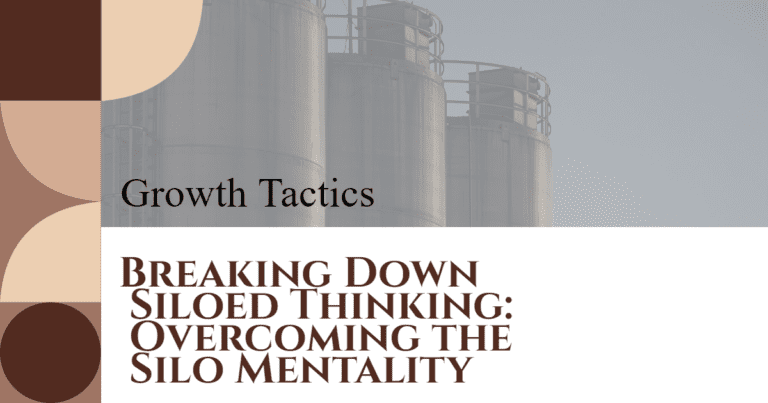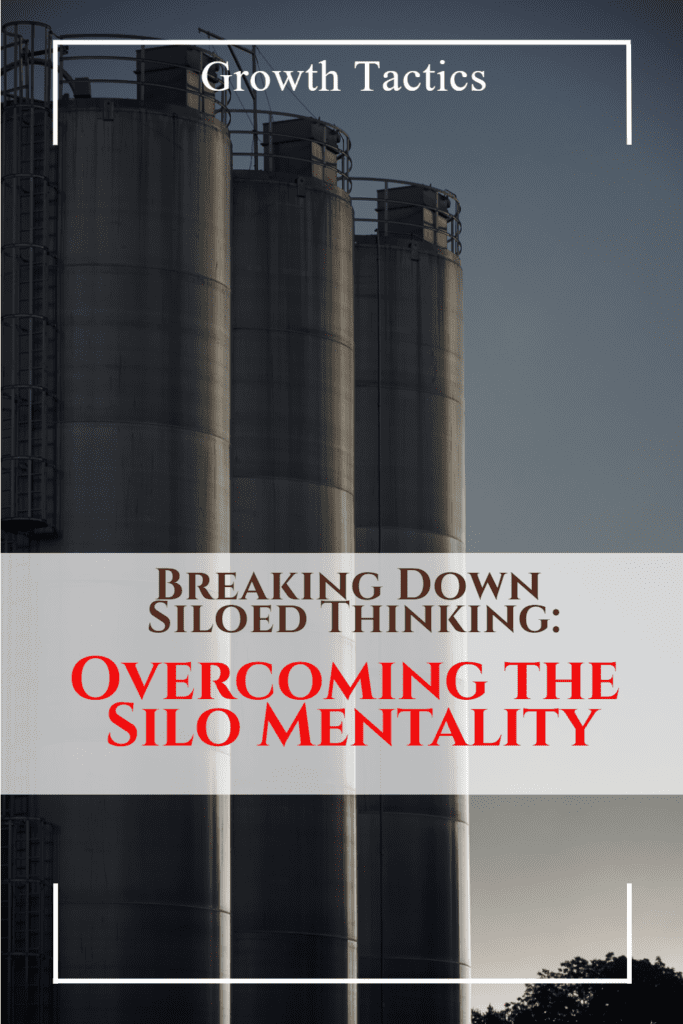As a leader, I understand the challenges that can arise from a silo mentality within organizations. That’s why I believe breaking down these barriers and fostering a culture of collaboration and communication is essential. In this article, I’ll delve into the concept of siloed thinking, discuss the impact it can have on productivity and customer experience, and share practical strategies for overcoming the silo mentality. Together, let’s break down those silos and unlock the full potential of our organizations!
Jump To Section
Understanding the Silo Mentality
Before we explore how to overcome the silo mentality, let’s first define what it means. Siloed thinking refers to the phenomenon where different departments or teams operate independently, without sharing information or collaborating with one another. This isolation can lead to duplication of efforts, errors, and missed opportunities. It’s like having separate silos within an organization, with limited communication and visibility across the board.
The Impact of Organizational Silos
When organizational silos take root within an organization, the impacts can be far-reaching and detrimental. Imagine each department operating like a lone island, focused solely on its own goals and objectives, without considering the larger organizational picture. This kind of mindset leads to fragmented work, wasted resources, and ultimately, a negative impact on productivity and the overall customer experience.
Narrow Focus: Missing the Forest for the Trees
Organizational silos create an environment where departments become myopically focused on their specific tasks and responsibilities. While this may seem like a recipe for increased efficiency, it actually hampers productivity in the long run. Without a holistic view of the bigger picture, departments may inadvertently duplicate efforts, overlook synergies, or fail to identify potential efficiencies. Resources that could be better utilized elsewhere end up wasted, and important opportunities slip through the cracks.
Fragmented Work: The Puzzle Pieces Don’t Fit Together
Picture a jigsaw puzzle where each department is a separate piece. Individually, the pieces might look great, but when you try to fit them together, they don’t quite match up. That’s the result of organizational silos. Each department is working in isolation, unaware of how their work aligns with the larger organizational objectives. This fragmentation leads to disjointed processes, inconsistent messaging, and a lack of collaboration. Ultimately, it slows down progress and inhibits the organization’s ability to adapt and respond to challenges in a nimble manner.
The Ripple Effect on Customer Experience
When the internal gears of an organization are grinding against each other due to siloed thinking, the effects are felt by the customer. Inconsistent information and disjointed processes can lead to a less-than-optimal customer experience. Customers may encounter confusion, delays, or even receive conflicting information from different departments. These issues erode trust and loyalty, jeopardizing the organization’s reputation and customer retention rate.
What Causes Organizational Silos?
Silos can be a real obstacle to progress and collaboration, impeding productivity, innovation, and growth. But what causes them? Let’s dive into some common culprits behind this phenomenon.
The Blame Game
One of the biggest sources of silos is the blame game. When departments or teams feel like they’re in competition with one another, finger-pointing and blame can become the norm. Rather than working together to solve problems, they start looking for ways to assign blame. This can cause mistrust and animosity to develop, further deepening the divide.
Communication Breakdowns
Another common cause of silos is a failure to communicate. When different departments and teams aren’t communicating effectively, essential information can slip through the cracks. This can create costly mistakes, delays, and missed opportunities. Poor communication can cause unnecessary tension and create a hostile work environment.
Power Struggles
Silos can also arise when there are power struggles between departments or teams. Each group may be vying for more control or trying to assert their dominance at the expense of others. This can lead to territorial behavior and a reluctance to share resources or information.
Fear of Change
Change can be scary, and some employees may be hesitant to break away from the status quo. This fear of change can create resistance to collaboration efforts and prevent teams from working together. Some employees may also fear that collaboration will lead to job losses or other negative outcomes.
Lack of Leadership
Finally, a lack of strong leadership can contribute to the silo mentality. When leaders fail to communicate a clear mission or vision for the organization, individuals may become more focused on their own team’s success rather than the bigger picture. Leaders must actively encourage collaboration and set an example for their team by working collaboratively with other departments.
Improving Productivity and Collaboration
When it comes to unlocking productivity and fostering innovation, breaking down silos and promoting cross-departmental collaboration is absolutely critical. Let’s dive into some effective strategies that can make a real difference:
Foster a Culture of Open Communication: Sharing is Caring
In order to foster collaboration and break down silos, it’s essential to encourage a culture of open communication within your organization. This means creating an environment where teams feel comfortable sharing information and knowledge freely. Consider implementing regular meetings or check-ins where different departments can come together and discuss ongoing projects, challenges, and progress. By facilitating a flow of information, you’re not only breaking down barriers but also helping to build strong relationships across the organization.
Promote Cross-Functional Teams: Strength in Diversity
Establishing cross-functional teams is a powerful way to overcome silos and promote collaboration. This approach brings together employees from different departments, allowing them to work together on specific projects or initiatives. By leveraging the diverse expertise and perspectives of team members, you can tackle challenges from multiple angles and generate innovative solutions. Breaking down the walls between departments creates a united front, where everyone can contribute their unique skills towards a common goal.
Implement Technology Tools: Unlocking Seamless Collaboration
In today’s digital age, technology can be a game-changer when it comes to breaking down silos and improving collaboration. Consider leveraging project management software, communication platforms, and document collaboration tools to facilitate seamless communication and information sharing. These tools ensure real-time updates, streamline workflows, and break down the barriers of physical distance and departmental boundaries. By embracing technology, you’re equipping your teams with the tools they need to collaborate effectively and work towards shared success.
Through fostering a culture of open communication, promoting cross-functional teams, and leveraging technology tools, you can begin to break down the barriers of siloed thinking and unlock the true potential of your organization. By embracing these strategies, you’re setting the stage for increased productivity, improved collaboration, and a culture of innovation. Let’s break those silos together and create a thriving, interconnected organization!
Remember, it’s not just about implementing these strategies, but also embodying a mindset of collaboration and continuous improvement. By leading the charge and setting an example, you’ll inspire others to follow suit. Together, let’s achieve greatness by breaking through those silo walls and working hand in hand toward a brighter future.
Enhancing the Customer Experience
When silos are dismantled, we can deliver a better customer experience. By breaking down communication barriers and fostering collaboration, employees can share valuable insights and knowledge that can lead to improved products, services, and customer interactions. It’s about aligning different departments towards a common goal: providing exceptional customer experiences.
Overcoming Resistance and Leading the Change
Breaking down the silo mentality can be a challenging task, no doubt about it. Change tends to encounter resistance, but that doesn’t mean it’s impossible to achieve. As a leader, it’s crucial for you to step up and guide your team through this transformative journey.
One of the key aspects of overcoming silos is effectively communicating the vision and benefits of collaboration. Help your employees understand how working together and breaking down departmental barriers can lead to improved productivity, creativity, and ultimately, better results for the whole organization.
But it doesn’t stop at just talking about it. Actively involve your employees in the process. Encourage open dialogue and provide a safe space for them to voice their concerns and share their ideas. Collaboration should be a two-way street, so make sure everyone feels heard and valued.
Addressing concerns head-on is also essential. Change can be scary, and it’s normal for people to worry about the impact it might have on their roles or workload. Take the time to address these concerns, provide reassurance, and clarify how collaboration will actually benefit both the organization as a whole and individual departments.
By embracing a more interconnected and collaborative approach, we can unlock the full potential of our organizations. Breaking down the silos will foster innovation, enhance problem-solving capabilities, and ultimately lead to exceptional customer experiences.
Yes, it may take effort, and you may encounter some roadblocks along the way. But trust me, the benefits far outweigh the challenges. Let’s work together to break those barriers, foster a culture of collaboration, and create an environment where everyone can thrive. Are you ready to make a difference?
Conclusion
The silo mentality can hinder productivity, collaboration, and the customer experience within organizations. However, with a proactive approach that fosters open communication, cross-departmental collaboration, and a focus on customer-centricity, we can break down silos and transform our organizations. It starts with us, the leaders, leading the change and setting the stage for a more connected, collaborative, and successful future. Together, let’s overcome the silo mentality and reap the rewards of a thriving, interconnected organization!


